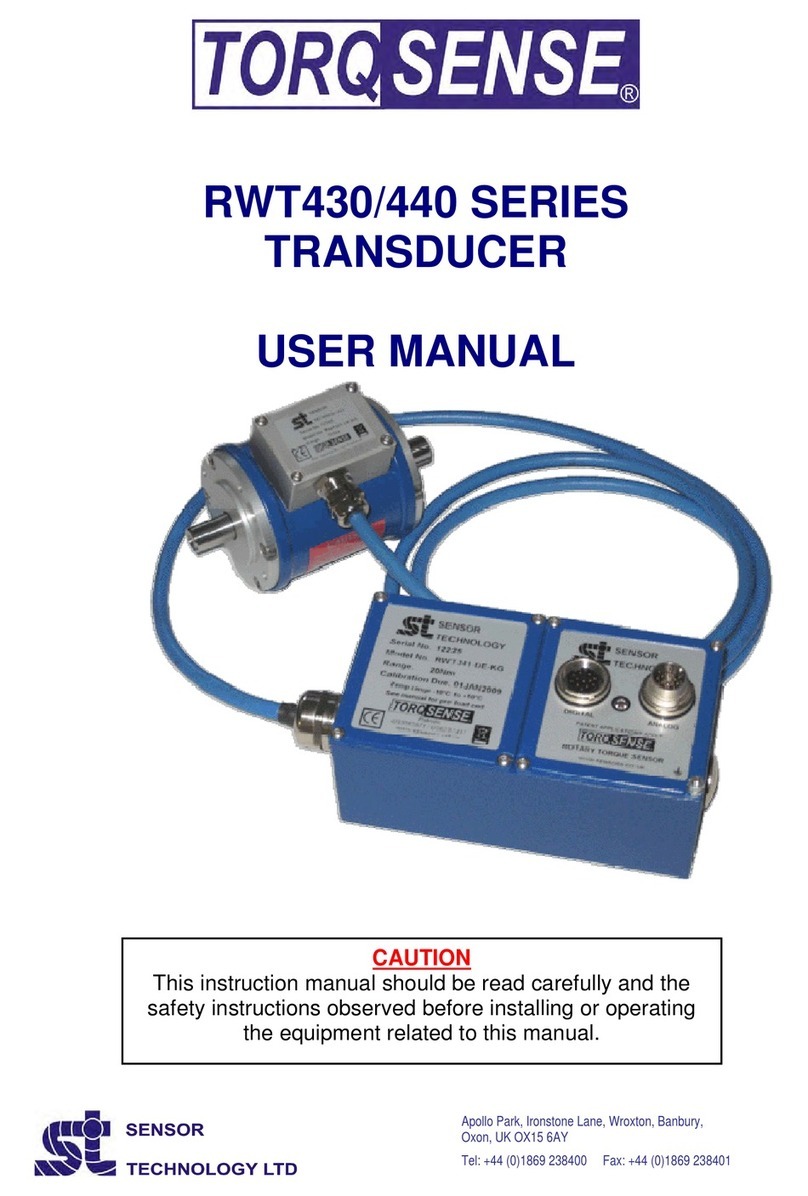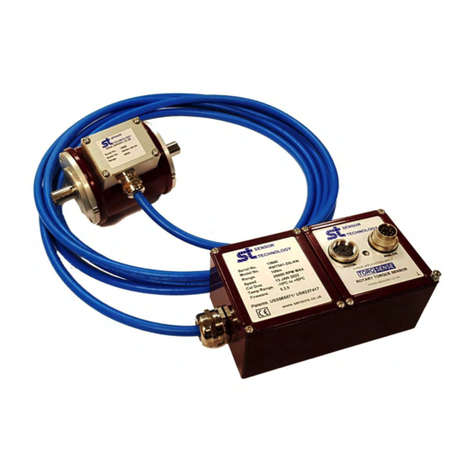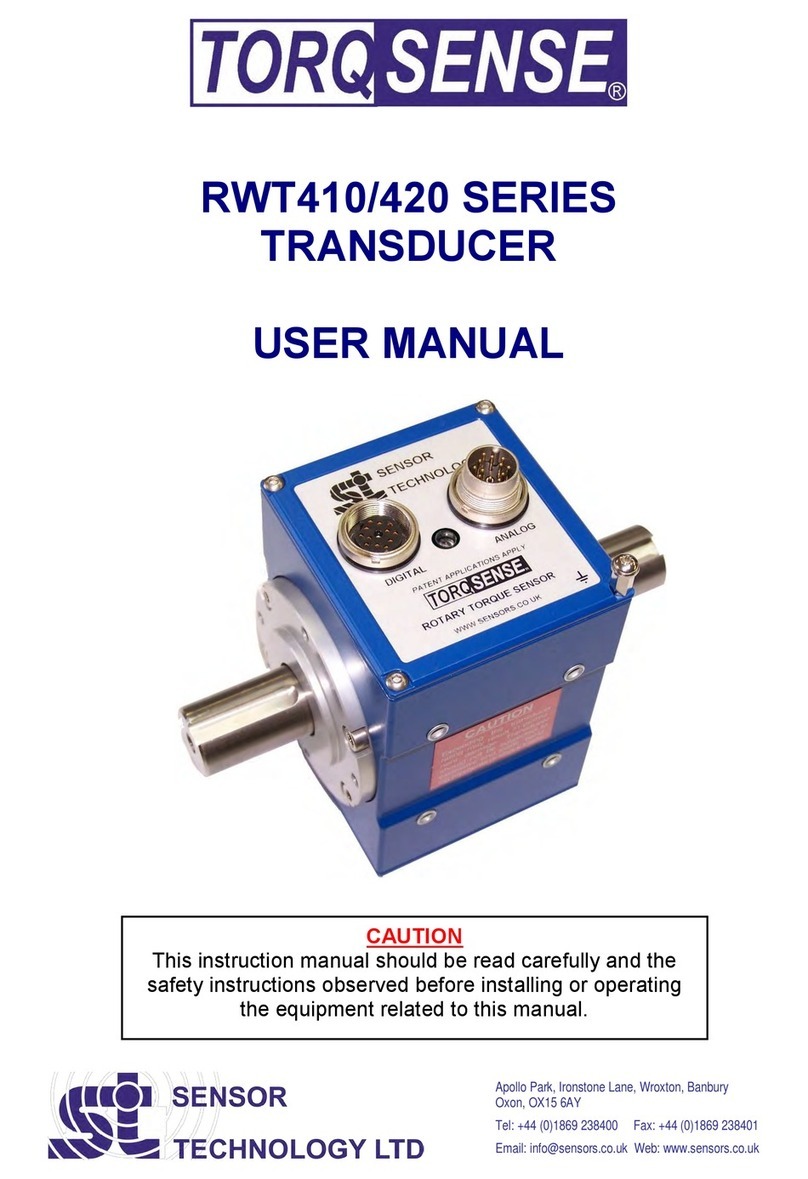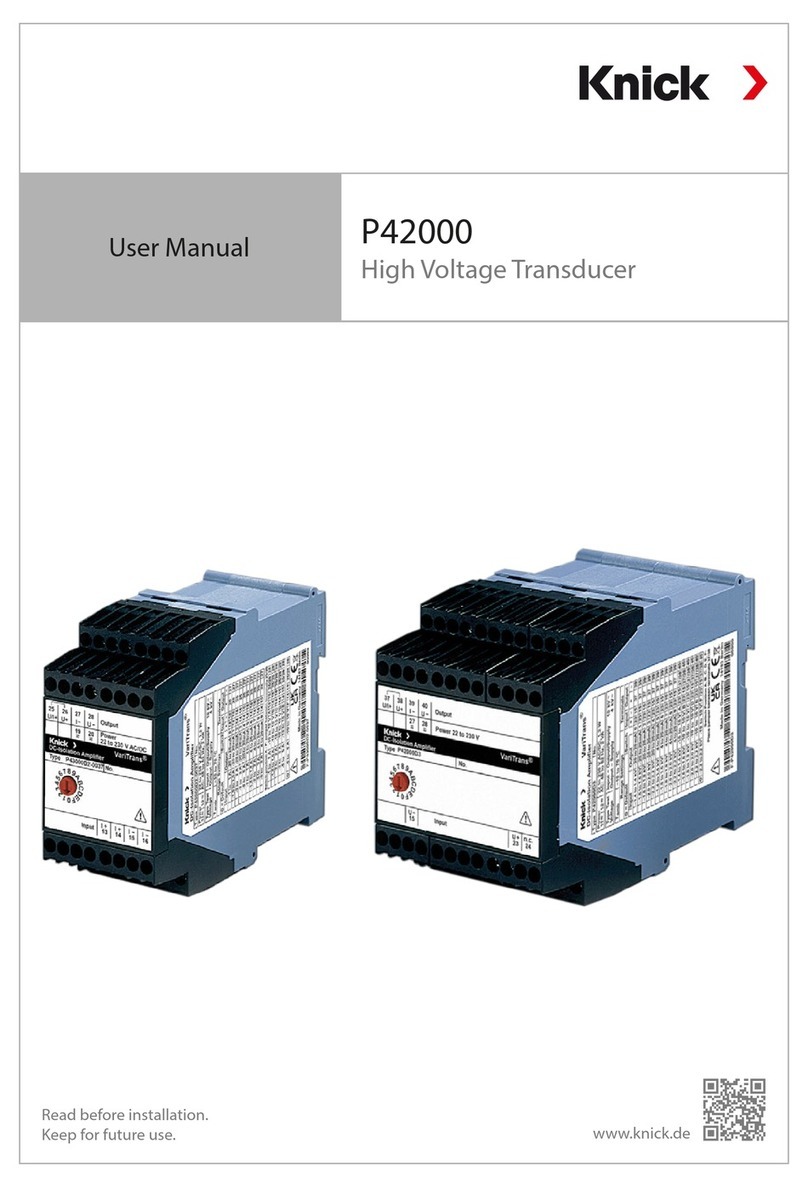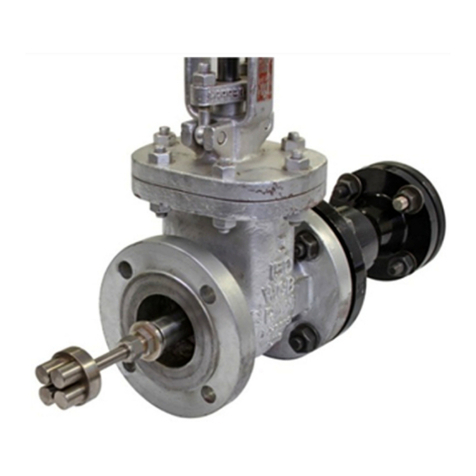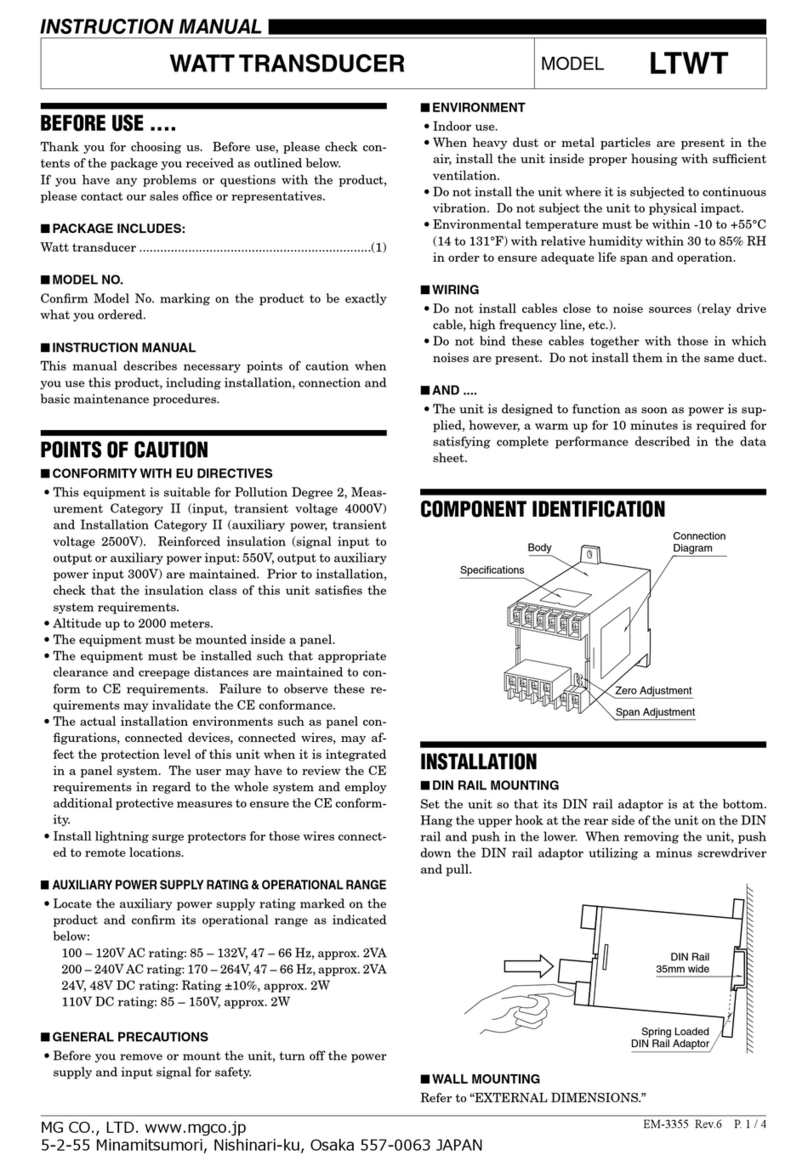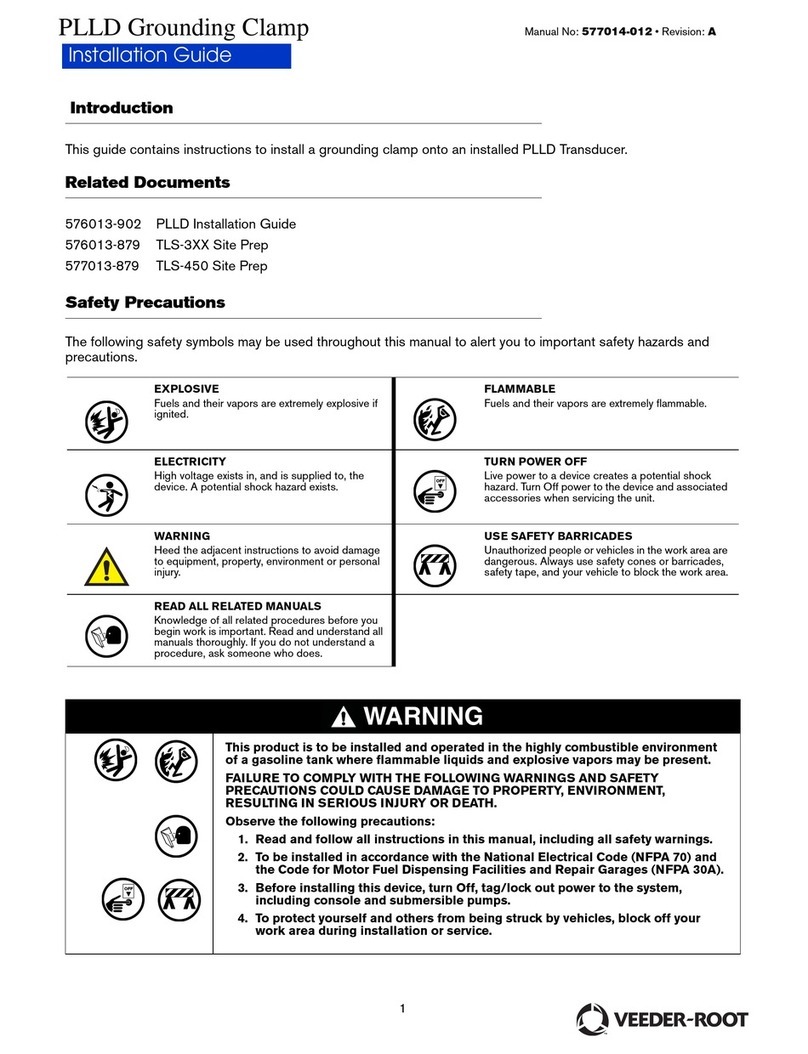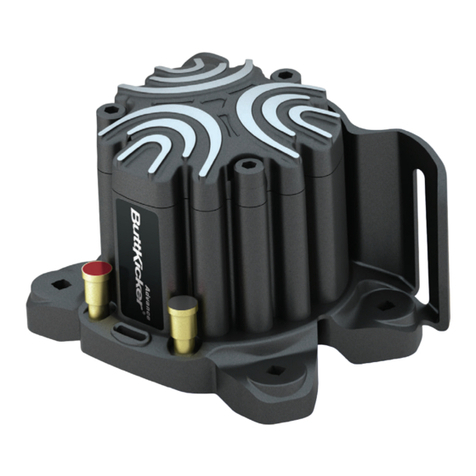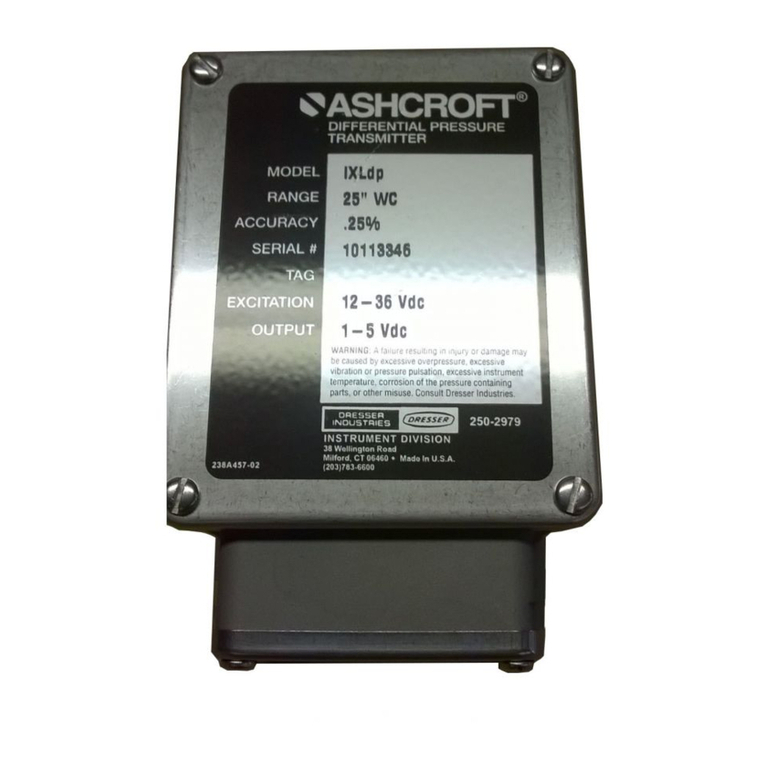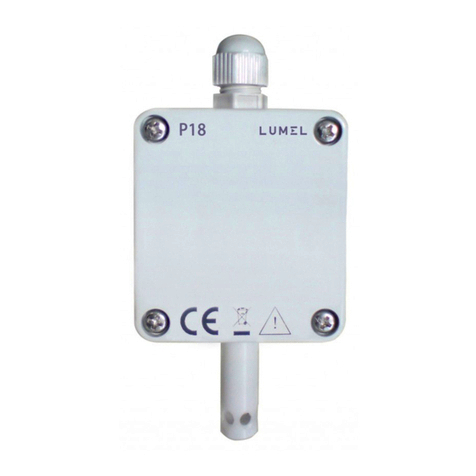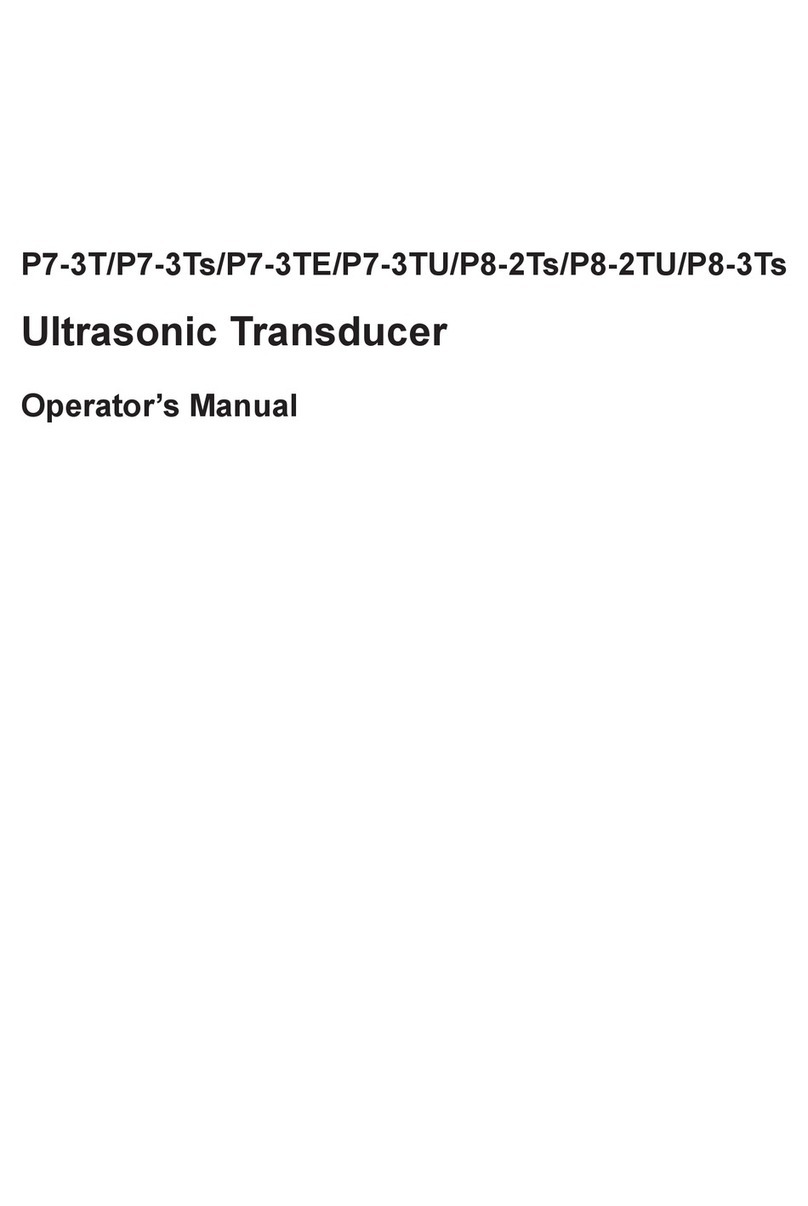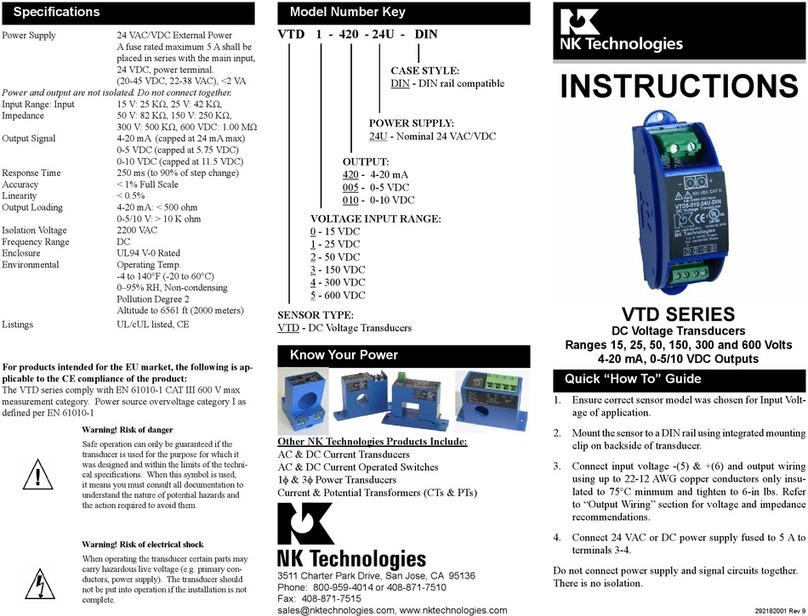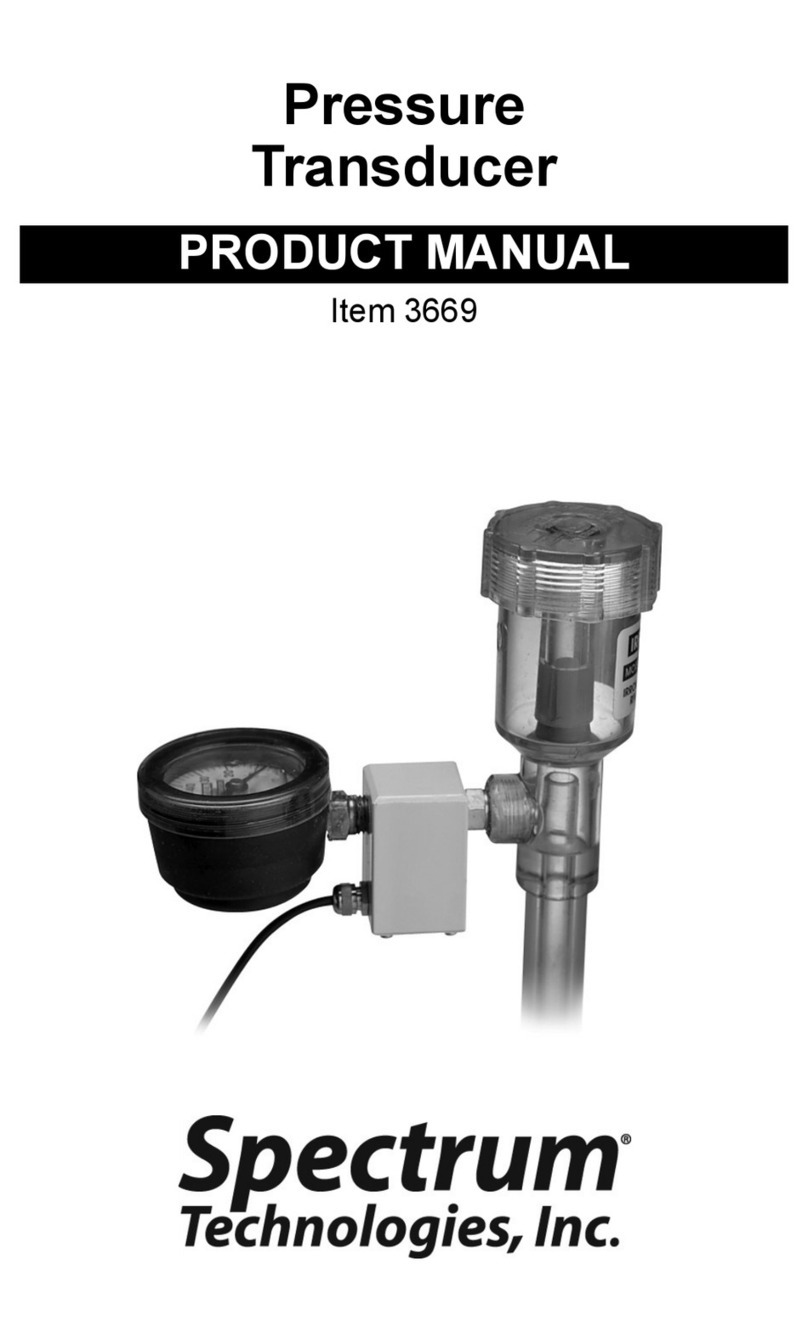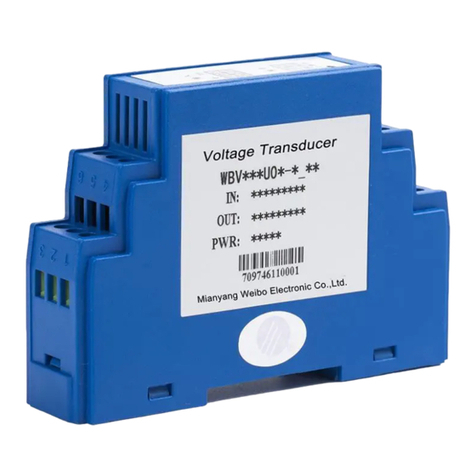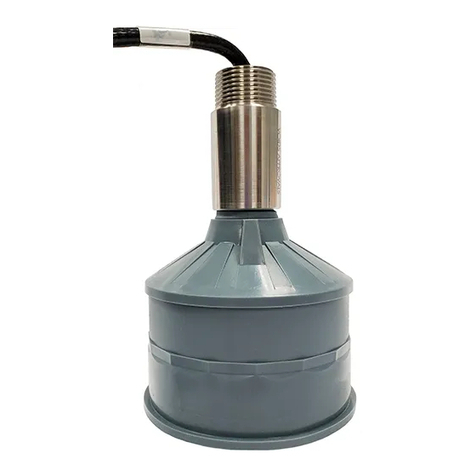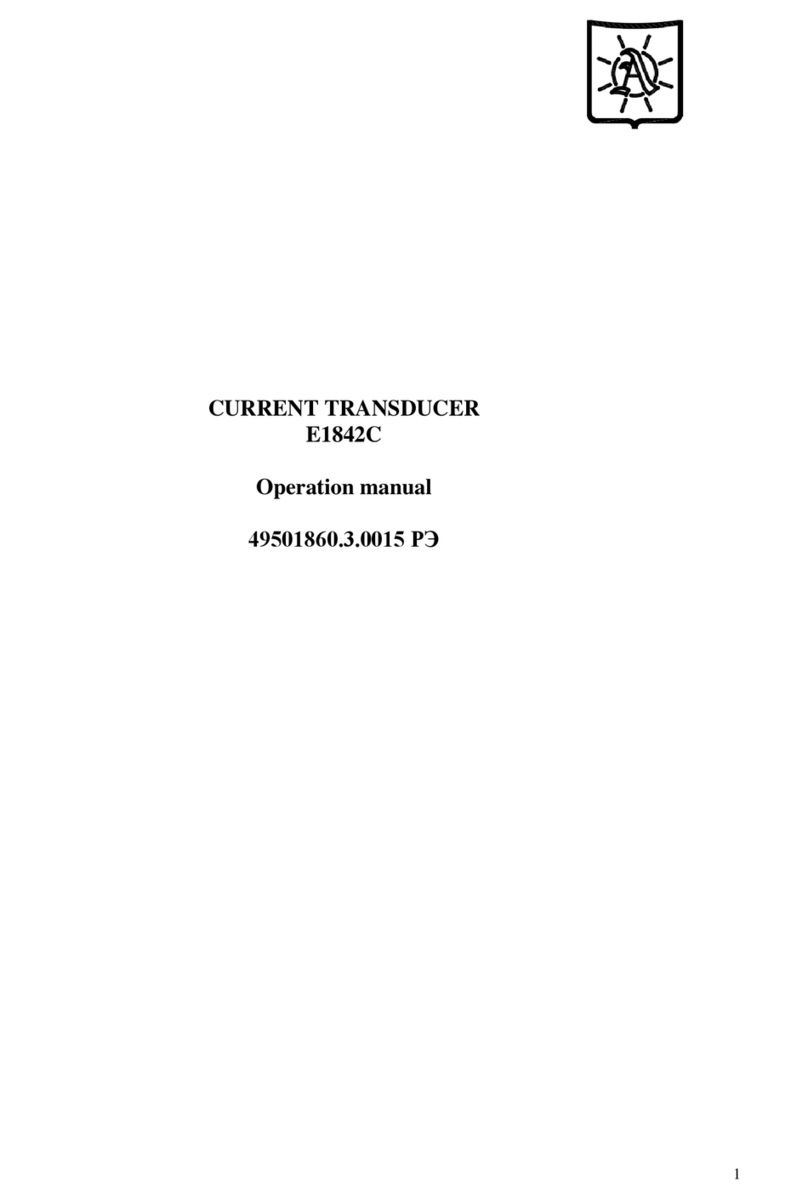Sensor Technology TorqSense SGR510 Series User manual

SGR510/520 SERIES
TRANSDUCER
USER MANUAL
CAUTION
This instruction manual should be read carefully and the
safety instructions observed before installing or operating
the equipment related to this manual.
Apollo Park, Ironstone Lane, Wroxton, Banbury
Oxon, OX15 6AY
Tel: +44 (0)1869 238400 Fax: +44 (0)1869 238401

©Sensor Technology 2020 Page 1 SGR4384V (Rev 1)
While every precaution has been exercised in the compilation of this document to ensure the
accuracy of its contents, Sensor Technology Ltd, assumes no responsibility for any errors or
omissions. Additionally, no liability is assumed for any damages that may result from the use of
the information contained in this document.
Copyright
Copyright © 2020 Sensor Technology Ltd. All rights Reserved.
Copying or reproducing of all or any part of the contents of this manual is strictly prohibited
without the express permission of Sensor Technology.
Trademarks
TorqSense is a registered trademark of Sensor Technology Ltd.
TorqView is a trademark of Sensor Technology Ltd.
LabVIEW is a trademark of National Instruments Corporation.
National Instruments is a trademark of National Instruments Corporation.
Windows is a registered trademark of Microsoft Corporation.
Lifetime Warranty
Sensor Technology Ltd’s standard range of products are warranted against manufacturing
defects and component failure for two years from date of purchase, subject to fair wear and
tear and return for the first year's free of charge annual re-calibration. This warranty is extended
indefinitely if the equipment is returned to Sensor Technology, or its distributor, for annual re-
calibration, when software and hardware updates, if required, will be carried out free of charge.
Standard range means those products as described in the company's product data sheets.

©Sensor Technology 2020 Page 2 SGR4384V (Rev 1)
Table of Contents
Getting Started ......................................................................................................................... 3
Introduction ............................................................................................................................ 3
Unpacking the transducer ..................................................................................................... 3
Mechanical Installation .......................................................................................................... 4
Operating Principles .............................................................................................................. 5
Operation .................................................................................................................................. 6
Powering the transducer ....................................................................................................... 6
Using the transducer ............................................................................................................. 6
Built In Test (BIT) .................................................................................................................. 7
Normal Operation .................................................................................................................. 8
Peak Mode........................................................................................................................ 8
Analog Scaling.................................................................................................................. 8
Warning Signals .................................................................................................................... 9
Error Signals ........................................................................................................................ 10
Peak Input ........................................................................................................................... 10
Analog Output................................................................................................................. 10
Peak Reset ..................................................................................................................... 10
Analog Outputs .................................................................................................................... 11
Data Assignments........................................................................................................... 11
Voltage/Current Assignments......................................................................................... 12
Fail Output ........................................................................................................................... 12
Limit Output ......................................................................................................................... 13
Zeroing the transducer ........................................................................................................ 14
Electrical Signal .............................................................................................................. 14
Digital Command ............................................................................................................ 15
Resetting transducer to factory default ............................................................................... 15
Examples of reading/collecting data ................................................................................... 16
Optional Accessories ............................................................................................................ 17
Analog Lead ........................................................................................................................ 17
Digital Lead (SGR520/540 series ONLY)............................................................................ 17
Digital Adaptor Lead (SGR520/540 series ONLY) .............................................................. 17
Additional Related Products and Transducer Resources ................................................. 17
Transducer Display ETD ..................................................................................................... 17
Transducer Signal Breakout Unit ........................................................................................ 17
AC Mains Adaptor Power Supply ........................................................................................ 17
TorqView (SGR520/540 series ONLY) ............................................................................... 17
Transducer Control Program (SGR520/540 series ONLY) ................................................. 17
Transducer Communication Protocol (SGR520/540 series ONLY) .................................... 17
Transducer DLL Programmers Guide (SGR520/540 series ONLY) ................................... 17
Leads ...................................................................................................................................... 18
Analog Lead - Pin Out ......................................................................................................... 18
Digital Lead - Pin Out (SGR520/540 Series ONLY) ............................................................ 19
Transducer Connections ...................................................................................................... 20
Analog ................................................................................................................................. 20
Digital .................................................................................................................................. 20
Data Specification . . . . . . . Attached
Appendices (SGR520/540 series ONLY)
1. SGR520/540 Series Transducer Control Utility
Attachments (the following documents may also be attached)
1. TorqView User Guide

©Sensor Technology 2020 Page 3 SGR4384V (Rev 1)
Getting Started
Introduction
The SGR Torque Transducer provides a method of precisely measuring bi-
directional rotary or static torque. It can also be fitted with a speed sensor for monitoring in
dynamic applications, enabling direct measurements of transmitted power.
The SGR series transducers require no external instrumentation and has its own built in test
capability. Its compact size makes it ideal for use in applications where there is little space for
any extra equipment. Analog voltage outputs are standard, with current outputs available as
an option. The SGR520/540 series can also be connected to a PC via USB (optional) or RS232
so that its configuration can be changed, or by using TorqView to display torque, speed and
power.
Unpacking the transducer
The following standard components are included:
▪ 1 x SGR Series Transducer
▪ 1 x SGR Electronics Module (Only if SGR530/540 ordered).
▪ 1 x User Manual.
▪ 1 x Calibration Certificate.
Additional components for SGR520/540 series:
▪ 1 x TorqView program installation USB flash drive, SGR Configuration Software,
Manuals & Appendices in PDF format, USB driver.
The following items may also be included:
▪ 12pin Lumberg (female) and/or 12pin Lumberg (male).
▪ 1 x 2.5m Analog Lead - 15 way ‘D’ type connector (female) to 12pin Lumberg (female).
▪ 1 x 2.5m Digital Lead - 15 way ‘D’ type connector (male) to 12pin Lumberg (male).
(SGR520/540 series transducer ONLY).
▪ 1 x Digital Adaptor Lead (DC Jack with USB and/or RS232 connections, depending on
options requested) (SGR520/540 series transducer ONLY).
▪ 1 x Transducer Display ETD
▪ 1 x AC Mains Adaptor Power Supply.
▪ 1 x Transducer Signal Breakout Unit.
▪ 1 x Analog Dongle.
CAUTION
The SGR series transducers should not be operated at any torque load greater or
speed faster than that specified in the Product data sheet and on the Transducer.
CAUTION
The SGR series transducers should be installed using correct couplings rated for
the maximum torque and speed for the operation.
CAUTION
The SGR series transducers should not be operated in an environment where that
operation could be life threatening or a danger to personnel.
CAUTION
In electrically noisy environments, the SGR series transducers should be earthed
using the earthing post located on the transducer.

©Sensor Technology 2020 Page 4 SGR4384V (Rev 1)
Mechanical Installation
To obtain the best measurements from your torque transducer it is essential that it is correctly
installed.
To avoid damaging the transducer during the installation process it is highly recommended
that it is electrically connected and working so that any torque overloads applied due to
handling can be monitored.
For Transducers above 1Nm or 10lbf.in. it is recommended that the body of the transducer
is restrained from rotation using a strap or straps connected to the tapped holes in the end
plates and that it is not rigidly mounted. Couplings should be used to allow for angular
misalignment while the transducer shaft takes up any parallel misalignment. Care should be
taken not to induce any end loads or bending moments to the shaft, see below, as these
may induce inaccuracies to the torque measurement and in extreme cases damage the
transducer.
Should rapid variations in torque need to be measured in detail e.g.
torque fluctuations in gearboxes or multi vane pumps then it is
recommended using torsionally rigid couplings fitted at both ends of
the transducer shaft such as single membrane couplings and that
these are correctly selected for the transducer rating and speed.
An undersized coupling will not transmit the torque while the high
inertia of an oversized coupling can result in instantaneous peak
torques far in excess of the measured torque. Alternatively, for lower
bandwidth applications where it is more important to measure the
‘average’ torque rather than fast torque fluctuations then couplings
with a degree of compliance would be more appropriate.
Never use a solid coupling to connect a SGR series transducers
Torque Transducer
For Transducers below 1Nm or 10lbf.in or if the application requires
the body to be rigidly mounted then it is recommended that double
couplings should be used at each end to compensate for any
misalignment of the input/output shafts and the system designed to
eliminate any end loads on the transducer shaft. For applications
where end loads cannot be avoided please consult the sales
department for advice prior to ordering.
When using a pulley or pulleys it is recommended a bearing block or
blocks should be used to ensure bending loads are not transmitted to
the transducer.
Lastly, consider using a guard over the transducer and couplings
Single membrane
coupling
(Flexible mounting)
Double membrane
coupling
(Rigid mounting)

©Sensor Technology 2020 Page 5 SGR4384V (Rev 1)
Whilst the transducer is resistant to EMC interference to BS EN 61326-1:2006, the
sensible routing of cables is important to avoid possible EMC interference. Avoid
running the transducer cables close, and/or parallel, to high voltage cables, solenoid
valves, generators or inverters etc. If the cables must follow the same route as
interfering cables then additional screening such as metal conduit should be used to
provide isolation.
To avoid damaging the transducer during installation it is highly recommended that it
is electrically connected and working during this process so that any torque
overloads due to handling can be monitored.
Operating Principles
SGR510/520 series transducers operate using a four-element strain gauge wheatstone bridge,
which is connected to a miniature shaft mounted analog to digital converter and microcontroller.
The microcontroller conditions and measures the strain gauge bridge output as close to the
gauges as possible, eliminating any possible external noise pick up in the gauge wiring.
The shaft mounted electronic module is wirelessly powered by a radio frequency source which
drives a stator coil, the output of which is received by a rotor coil on the shaft thus making the
system completely contactless. This eliminates the need for slip rings and their associated wear
and noise problems.
The shaft microcontroller outputs a digital serial stream that is transferred back from rotor to
stator by modulating the impedance of the rotor coil and detecting the impedance changes at
the stator coil. A secondary high-performance microcontroller receives the serial stream from
the shaft microcontroller, which then performs calibration and temperature compensation
before outputting the results digitally via RS232, CAN bus or USB. A 16-bit digital to analog
converter also outputs the sensors data as a fully calibrated and compensated analog voltage
or current.
Pre-load, note:
All SGR510/520 transducers with a LED in the centre of the front label (connector side) have
a bearing pre-load spring fitted internally at the left hand side (pre-load end) when viewing the
front label of the transducer and with the earth stud bottom ride hand corner.
All SGR530/540 transducers with a LED on the separate electronics module have a bearing
pre-load spring fitted internally at the left hand side (pre-load end) of the transducer head when
viewing the label of the transducer head and the connector and gland facing towards you.
If there is a possibility of an end load being applied to the transducer, the transducer
should be orientated during installation such that the load is applied at the pre-load end
(side with the internally fitted spring). Excessive end loads must be avoided and it is
recommended that appropriate couplings be used to compensate for axial and radial
misalignment.

©Sensor Technology 2020 Page 6 SGR4384V (Rev 1)
Operation
Powering the transducer
To power the transducer a supply voltage of 12-32VDC is required with a minimum current of
1 amp (to supply peak start-up current). If a Transducer Display ETD is used the ETD will
provide power for the transducer. If a Transducer Signal Breakout Unit is used the power
supply should be plugged into the DC jack on the box. If a Digital Adaptor Lead is used the
power supply should be plugged into the DC jack on the lead.
If a Transducer Display ETD, Transducer Signal Breakout Unit or a Digital Adaptor Lead is not
used, then the power supply can be provided by using either the 2.5m Analog or Digital Lead’s
15 way ‘D’ type connector with a supply voltage of 12-32VDC on Pin 1 and Ground on Pin 2.
Note: It is imperative that the voltage does not drop below 12V at any stage.
Using the transducer
1. Switch on the SGR series transducer by ensuring power is supplied.
2. Allow the transducer to carry out its Built In Test (BIT) procedure. Refer to the Built In
Test section for further details.
3. Allow five minutes for the equipment to reach thermal equilibrium before making any
measurements.
4. Zero the transducer, refer to the Zeroing the transducer section.
5. The transducer is ready for use, examples of different ways to extract data can be
found in the Examples of reading/collecting data section.
CAUTION
Only provide power through either the Analog or Digital lead.
Do NOT provide power through both leads simultaneously.

©Sensor Technology 2020 Page 7 SGR4384V (Rev 1)
Built In Test (BIT)
When the SGR series transducer is switched on it will carry out its Built In Test (BIT) procedure.
While the BIT procedure is taking place there will be a series of green flashes from the LED,
this is followed by a steady green or an intermittent green flash depending upon the mode of
operation.
If the transducer fails its BIT procedure the transducer will display an error sequence identifying
the results of each system test. The sequence will repeat until the transducer is powered off.
The error sequence is prefixed with quick succession of red flashes, identifying the LED
sequence as an error condition
After a pause a sequence of green and red flashes will indicate the results of each system test.
The following table lists the tests and there test order, for each test the transducer will output
either a GREEN for PASS or RED for FAIL.
Test/Sequence Number
System Checks
1
Firmware Version 3/4: Head Connected Check
Firmware Version 5: Electronics Check
2
Shaft Electronics
3
Temperature Sensor Check
4
Internal Voltage Check
5
Data Configuration Check
6
Calibration Check
7
SAW Parameters Check
8
ORT Parameters Check
9
SGR Parameters Check
If a failure condition exists try power cycling the transducer. Contact the factory if the problem
continues.
If an error occurs during operation (solid RED LED) and is not present on power on, the BIT
procedure may not identify the fault. If the Zero Input has been wired it is possible to display
the Built In Test output, to do this switch the Zero Input ON until the transducer starts flashing
RED.

©Sensor Technology 2020 Page 8 SGR4384V (Rev 1)
Normal Operation
A solid green LED indicates normal mode and the transducer is working correctly.
An intermittent green flash indicates a special mode of operation; the led sequences below
show the different modes.
Peak Mode
Peak Mode is active, if configured to do so the analog output will output a peak value. Please
refer to the Peak Input section for further details.
Analog Scaling
The Analog Scaling status message is shown when a user defined data or voltage scale has
been applied to either analog channel. This message is only relevant on SGR520/540 series
transducers.
Peak Mode
Peak Mode and Analog Scaling
[SGR 520/540 Series ONLY]
Analog Scaling
[SGR 520/540 Series ONLY
]

©Sensor Technology 2020 Page 9 SGR4384V (Rev 1)
Warning Signals
A warning signal is indicated when the transducer detects a condition which impedes normal
operation or the transducer is operating outside of normal operating parameters.
A warning LED sequence is prefixed with a quick succession of alternating red/green flashes,
identifying the LED sequence as a warning condition. A warning sequence will override the
normal operation mode LED.
After a pause a sequence of green or red flashes will indicate which warning conditions are
flagged. The LED sequence will iterate through each of the flags in the table below flashing the
LED for each. A RED flash indicates that a condition has been flagged; a GREEN flash indicates
that a condition is clear.
Once the LED sequence is complete the sequence will restart, this will continue until the
warning has cleared.
Sequence
Number
Warning Flag
Reason and Action required
1
Analog Fault CH0
(Analog Torque)
In voltage output mode the analog pin is short circuit,
in current output mode the analog output pin is open
circuit. Check the analog connector wiring for Analog
CH0.
2
Analog Fault CH1
(Analog Speed)
In voltage output mode the analog pin is short circuit,
in current output mode the analog output pin is open
circuit. Check the analog connector wiring for Analog
CH1.
3
Zero Offset High
A torque offset greater than 10% of FSD has been
applied to the measured torque value. The offset is set
when the transducer is zeroed, either by the zero input
on the analog connector or via a digital command.
4
Exceeded Temp
Shaft temperature has exceeded normal operating
conditions. Temperature compensation may no longer
be effective or calibration valid.
5
Over Torque
Torque greater than the FSD has been applied.
6
Critical Over Torque
Torque greater than 120% of the FSD has been
applied. Contact the factory if the warning continues.
7
Head Disconnect
The transducer head has been disconnected. Power
off the transducer electronics and check the cabling.
This warning is only relevant for transducers with
separate heads.
For example, the following sequence would indicate warnings for ‘Analog Fault CH0’ and ‘Zero
Offset High‘:

©Sensor Technology 2020 Page 10 SGR4384V (Rev 1)
Error Signals
An error or fault signal is indicated when the transducer detects a condition which effects its
fundamental operation. An error or fault condition will be indicated by a solid red LED. Any error
that occurs will latch the LED on and it will remain on until the transducer is reset. An error
condition will override a warning and normal mode LED sequence.
If the error persists across multiple power cycles, a fault may have developed with the
transducer and you will need to contact the factory.
Peak Input
The peak input is a control signal and has two main purposes. It controls what data gets
applied to the torque analog output and it can be used to reset the peaks.
The peak input is activated by grounding pin 8 of the Analog 15 Way ‘D’ Socket. The best way
to control the peak input is to use a toggle switch.
Analog Output
When activated any analog output channel configured as “Torque – Auto Assign” will switch
from being the current torque value to the highest measured torque value since reset, if the
analog output is not unipolar then the torque direction will be output.
Peak Reset
When the peak input is toggled, i.e. off-on-off or on-off-on, all internal peak values on both
analog and digital interfaces will be reset to defaults. A peak input toggle will also clear any
latched fault condition.

©Sensor Technology 2020 Page 11 SGR4384V (Rev 1)
Analog Outputs
The transducer has two analog outputs which can be configured to different data values,
voltages, currents and scales.
Basic models are preconfigured based on model and options selected, advanced models hand
the configuration to the user. The configuration of the analog outputs for advanced models is
done using Transducer Control; please refer to the Transducer Control manual for further
details.
The following tables show the default assignments for each model and analog option.
Data Assignments
Model
Analog CH0 (Torque)
Analog CH1 (Speed)
ORT230
Torque – Auto Assign1
Scale: 0 – FSD
Torque – Peak
Scale: 0 – FSD
SGR510
SGR530
ORT231
Torque – Auto Assign1
Scale: 0 – FSD
Speed Fast (RPM)
Scale: 0 – Max Speed
ORT232
SGR511
SGR512
SGR531
SGR532
ORT233
Torque – Auto Assign1
Scale: 0 – FSD
Power (Watts)
Scale: 0 – ((FSD x Max Speed) /
9.551)
SGR513
SGR533
ORT240
Advanced Model - User
Selectable
Factory Default:
Torque – Auto Assign1
Scale: 0 – FSD
Advanced Model - User Selectable
Factory Default:
Torque – Peak
Scale: 0 – FSD
SGR520
SGR540
ORT241
Advanced Model - User
Selectable
Factory Default:
Torque – Auto Assign1
Scale: 0 – FSD
Advanced Model - User Selectable
Factory Default:
Speed Fast (RPM)
Scale: 0 – Max Speed
ORT242
SGR521
SGR522
SGR541
SGR542
1The value output by channels assigned with Torque – Auto Assign is dependent on the peak
switch. If unconnected or if Peak is OFF the channel is assigned with Torque, if Peak is ON the
channel is assigned with Torque – Peak. Refer to the Peak Input section for more details.

©Sensor Technology 2020 Page 12 SGR4384V (Rev 1)
Voltage/Current Assignments
Assignments apply to both channels.
Option
Analog Output Type
Analog Output
OPTN-A
ORT23x/SGR51x/SGR53x
Voltage
Bipolar ±1V, 0V Zero
OPTN-B
ORT23x/SGR51x/SGR53x
Voltage
Bipolar ±5V, 0V Zero
OPTN-C
ORT23x/SGR51x/SGR53x
Voltage
Bipolar ±10V, 0V Zero
OPTN-D
ORT23x/SGR51x/SGR53x
Current
0 - 20mA
OPTN-E
ORT23x/SGR51x/SGR53x
Current
4 - 20mA
OPTN-U
ORT23x/SGR51x/SGR53x
Voltage
User specified when ordered
check transducer label
OPTN-V
ORT23x/SGR51x/SGR53x
Current
±8mA, 12mA Zero
Advanced Model
ORT24x/SGR52x/SGR54x
Voltage
User Selectable
Factory Default:
Bipolar ±10V, 0V Zero
Advanced Model (OPTN-F)
ORT24x/SGR52x/SGR54x
User Selectable
Voltage/Current
User Selectable
Factory Default:
Bipolar ±10V, 0V Zero
Fail Output
The fail output signals when an error or fault condition occurs within the transducer. The fail
output is linked to the internal transducer error flag. Any error condition detected will switch the
output on and will remain on until the error clears. This behaviour is different from the LED
which latches.
The best use of the fail output is as a safety shutdown signal.
The fail signal is an open collector output. The circuit diagram below shows an example of how
to wire an LED to the output.
In firmware prior to version 5 the fail output is shared with the limits module. If the limits
module is active the fail output is overridden.

©Sensor Technology 2020 Page 13 SGR4384V (Rev 1)
Limit Output
The limit output is driven by the limits module. The limits module is a configurable set of
parameters which switch the limit output on or off when certain conditions are met. These
conditions include triggering when torque or speed goes above or below a set level, as well as
more advanced processes like auto reset or triggering after a delay
The limits module is configured using Transducer Control; please refer to the Transducer
Control manual for further details.
The limit signal is an open collector output. The circuit diagram below shows an example of
how to wire an LED to the output.
In firmware prior to version 5 the limits module does not have a dedicated output pin, instead
the limit output is routed to the Fail Output pin (11). When the limits module is active the fail out
signal is overridden.

©Sensor Technology 2020 Page 14 SGR4384V (Rev 1)
Zeroing the transducer
Zeroing the transducer has the effect of introducing an offset to the torque reading. The zero
can be used to remove any offset that may have been introduced from its mechanical
installation or from idle torque present. It must be stressed that the zero offset is no substitute
for correct installation.
When using high zero offsets, care must be taken not to overstrain the transducer. A zero offset
will not extend the full scale rating of the transducer, e.g. if a transducer was zeroed at 50%
then a further 50% was applied, the transducer will have reached full scale, even though the
transducer would be reading of 50%. A zero offset of 10% or greater will trigger a warning
condition and will be indicated by a warning LED sequence.
The transducer can be zeroed by using either a digital command or an electrical signal.
There are 3 zero modes that can be used:
▪ Normal Zero: Sets the zero offset to the current torque reading.
▪ Average Zero: Sets the zero offset to the average of 8 consecutive torque readings.
▪ Fixed Zero: A fixed value can be input and saved. Fixed Zero is only available in
Transducer Control.
Unless the zero is saved, any zero offset applied will be lost after a power cycle.
Electrical Signal
Zeroing the transducer electrically can be achieved by grounding the Zero Input on pin 7 of the
Analog 15 Way ‘D’ Socket. The best way of zeroing a transducer is to use a push button. A
simple circuit diagram using a push button is shown below.
The zero action is only carried out once the input has been ungrounded. Grounding the zero
input momentarily (less than 2 seconds) will initiate a normal zero, grounding the input for longer
will initiate other modes. When the zero input is grounded for more than 2 seconds the LED will
start flashing to indicate that a new mode has been selected, subsequent mode changes are
shown by an increase in flash frequency. The LED will not flash if an error condition is present.
The table below shows the various modes and timings.
Ground Hold Time
LED Flash
Zero Mode / Action
0 - 2 Seconds
None
Normal Zero
4 - 6 Seconds
1 Hz Green Flash
Average Zero
Greater than
6 Seconds
2 Hz Green Flash
Transducer will save the current zero
offset so that it is remembered across
power cycles.

©Sensor Technology 2020 Page 15 SGR4384V (Rev 1)
Digital Command
There are multiple digital commands to select the different zero modes, refer to the transducer
communication protocol manual.
Our Torqview and Transducer Control software programs implement these commands
providing a simple way of zeroing the transducer.
Resetting transducer to factory default
To reset the transducer to the factory default settings (i.e. the functions set by the factory on
purchase) follow the steps below:
1. Turn off transducer.
2. While holding in the zero button, power the transducer. The LED will stay solid green
until the zero button is released.
3. Allow the transducer to carry out its BIT procedure.
4. When the LED is solid green all user-adjusted parameters will have been reset to the
factory defaults.

©Sensor Technology 2020 Page 16 SGR4384V (Rev 1)
Examples of reading/collecting data
For diagrammatic purposes only the SGR510/520 model is shown.

©Sensor Technology 2020 Page 17 SGR4384V (Rev 1)
Optional Accessories
Analog Lead
The Analog Lead is a 2.5m length - 15 way ‘D’ type connector (female) to 12 pin Lumberg
(female). It can be used for any SGR series transducers.
Digital Lead (SGR520/540 series ONLY)
The Digital Lead is a 2.5m length - 15 way ‘D’ type connector (male) to 12 pin Lumberg (male).
It is used to configure the SGR520/540 series.
Digital Adaptor Lead (SGR520/540 series ONLY)
The Digital Adaptor Lead is an optional accessory and plugs into the 15 way ‘D’ type connector
on the 2.5m Digital Lead to provide a DC jack for power and RS232 and/or a USB connection,
depending upon the options requested. Note: USB specification limits the length of a cable
between host and full speed device to 5 meters. A USB Extender is required for distances
greater than 5m; please consult the factory for USB Extenders.
Additional Related Products and Transducer Resources
Transducer Display ETD
The Transducer Display ETD is a readout suitable for all SGR transducers. Although it is
primarily used to display torque and peak torque, it can also display speed and power, provide
access to the analog outputs from the transducer and connect the transducer to a PC for use
with TorqView and Transducer Control.
Transducer Signal Breakout Unit (SBU)
The Transducer Signal Breakout Unit, which when plugged in powers the transducer and keeps
all of the inputs and outputs in one place. The Transducer Signal Breakout Unit provides 4mm
sockets to output an analog torque and speed signal. It enables switching between DC Volts,
0-20mA, 4-20mA, zero torque, angle and enable peak hold. The Transducer Signal Breakout
Unit also allows communication with a PC via the built-in USB and RS232 ports. The
Transducer Signal Breakout Unit is powered by a supply voltage of 12-32VDC with a minimum
current of 1 amp (to supply peak start-up current).
AC Mains Adaptor Power Supply (PSU)
The AC Mains Adaptor Power supply is required to provide 12-32VDC to the SGR series
Transducer and Transducer Signal Breakout Unit.
TorqView (SGR520/540 series ONLY)
TorqView is an easy to use graphical front end Virtual Instrumentation Display PC Interface
Software program for use with the SGR520/540 series transducers. It allows the Torque,
Speed, Power and Temperature values to be displayed in charts, dials and digital bars and can
be used to assist data recording. For further information on TorqView please refer to the
TorqView User Manual.
Transducer Control Program (SGR520/540 series ONLY)
Transducer Control is an all-round application to unlock the advanced functionality of the
520/540 Series Transducer. Transducer Control enables the user to exploit the flexibility of the
advanced transducer series by configuring the run time parameters of the transducer to best
suit their application.
Transducer Communication Protocol (SGR520/540 series ONLY)
The Transducer Communication Protocol describes the protocol required to communicate with
a transducer on either RS232 or USB. The Transducer uses a simple request and send
protocol, which defines the commands for requesting data and configuring functionality. Further
information on the Transducer Communication Protocol is available from the factory or as a
download from our website: www.sensors.co.uk/documents
Transducer DLL Programmers Guide (SGR520/540 series ONLY)
The Transducer DLL Programmers Guide provides information on how a transducer can be
integrated into a third party software program. The DLL simplifies the use of the USB and
RS232 interfaces by providing a unified interface to access transducers connected via either
method; it takes care of the low-level driver access, protocol negotiation and data manipulation.
Further information on the Transducer DLL Programmers Guide is available from the factory or
as a download from our website: www.sensors.co.uk/documents

©Sensor Technology 2020 Page 18 SGR4384V (Rev 1)
Leads
Analog Lead - Pin Out
2.5m length - 15 way ‘D’ type connector (female) to 12 pin Lumberg (female)
15way ‘D’ type connector (Pwr&Out)
12 Pin male on transducer
Pin
Description
Pin
1
12-32VDC input
G
2
GND
M
3
Analog GND
J
4
Analog CH1 / Speed (V or I)
E
5
Analog CH0 / Torque (V or I)
C
6
Reserved
K
7
Zero Input (low = zero)
A
8
Peak Input (low = peak)
B
9
Reserved
F
10
Limit Output
D
11
Fail Output
L
12
GND
H
Female 15 way ‘D’
Female 12 way
Lumberg
Do NOT supply any
voltage to these ports.
Closure to ground only

©Sensor Technology 2020 Page 19 SGR4384V (Rev 1)
Digital Lead - Pin Out (SGR520/540 Series ONLY)
2.5m length - 15 way ‘D’ type connector (male) to 12 pin Lumberg (male)
15 way ‘D’ type connector (Pwr&Out)
12 Pin female on transducer
Pin
Description
Pin
1
12-32 VDC Input
G
2
GND
E
3
RS232 RXD / CAN LO
A
4
GND
5
RS232 TXD / CAN HI
K
6
GND
7
USB +
C
8
USB -
L
9
USB 0V
D
10
USB Power
B
11
Fail Output
H
12
+5V OUT
F
13
Zero Angle
J
14
RPM
M
Male 15 way ‘D’
Male 12 way
Lumberg
DIN45321 0332 12
SGR520/540 Series ONLY
This manual suits for next models
22
Table of contents
Other Sensor Technology Transducer manuals
